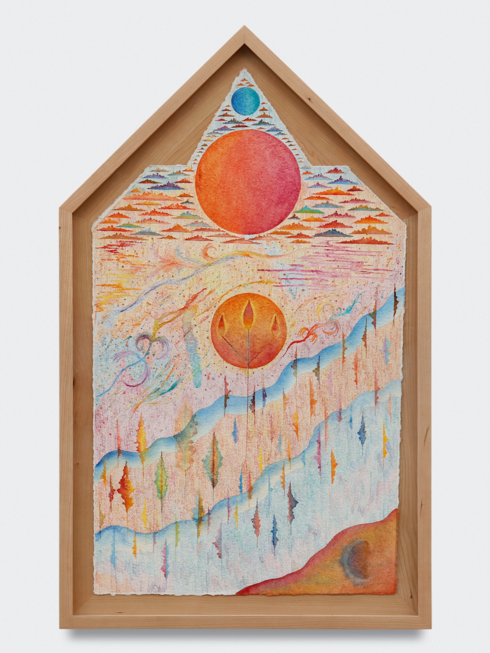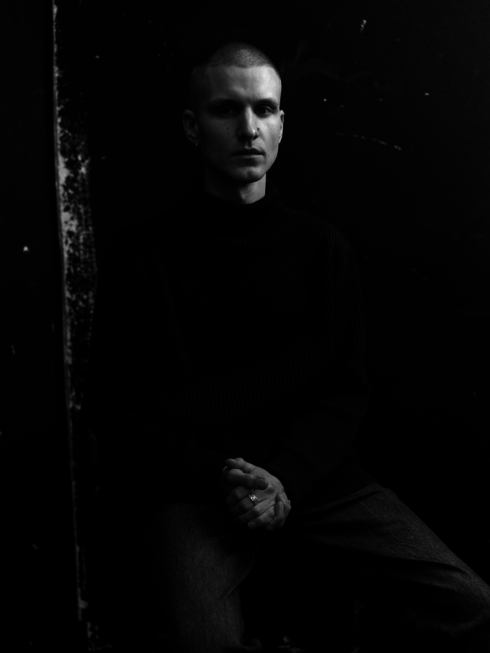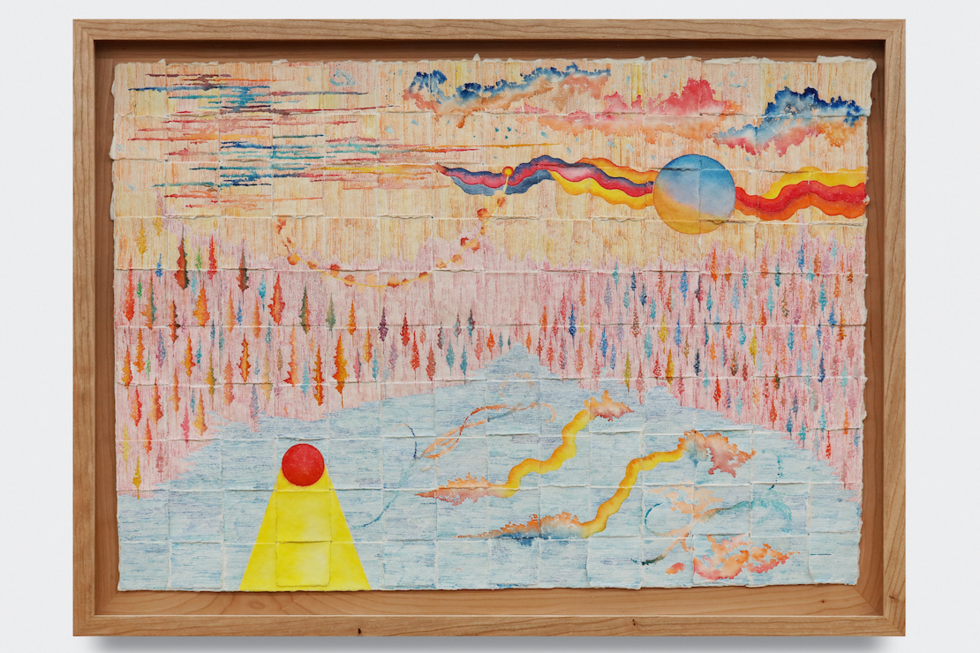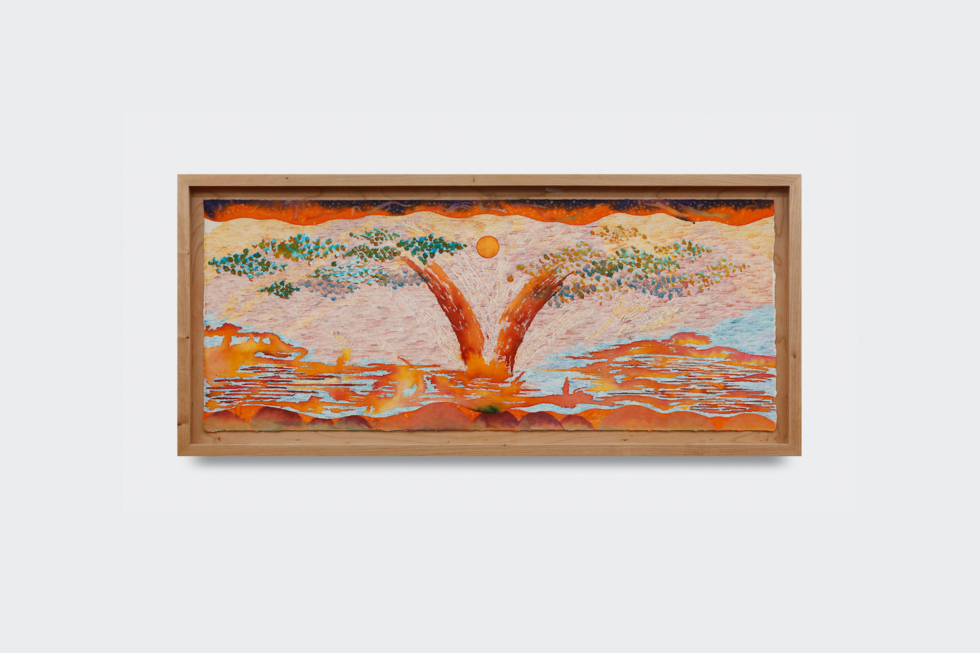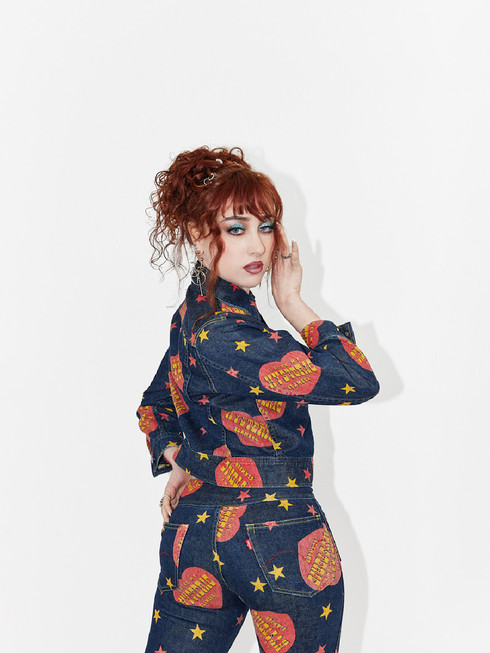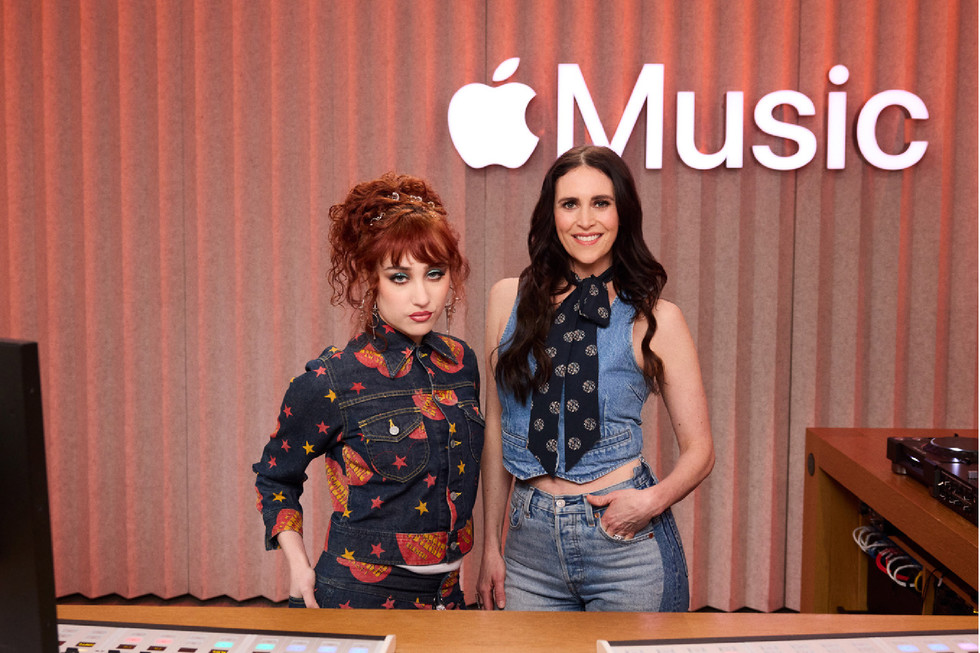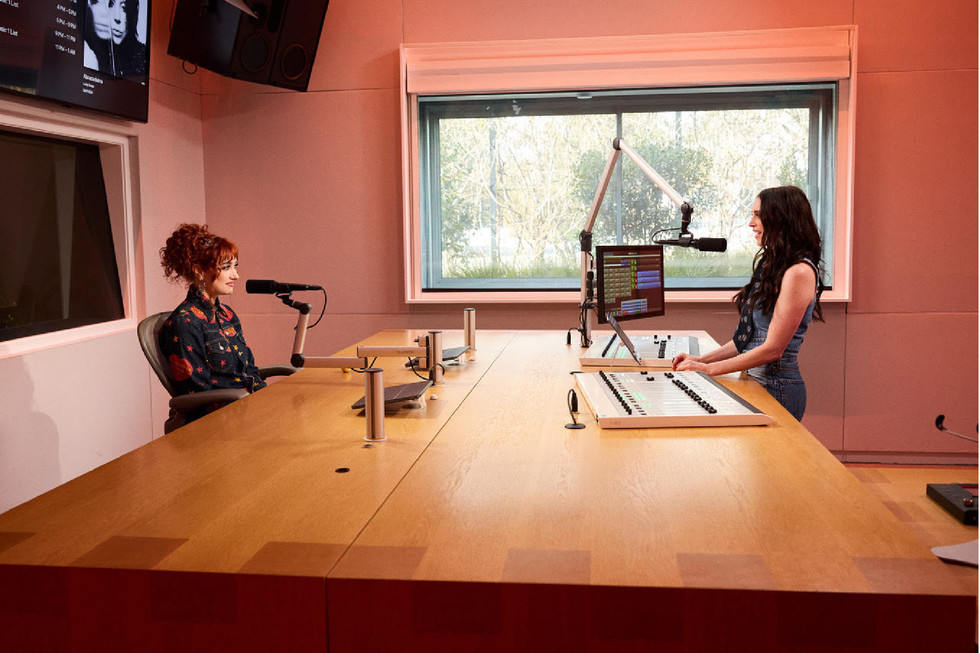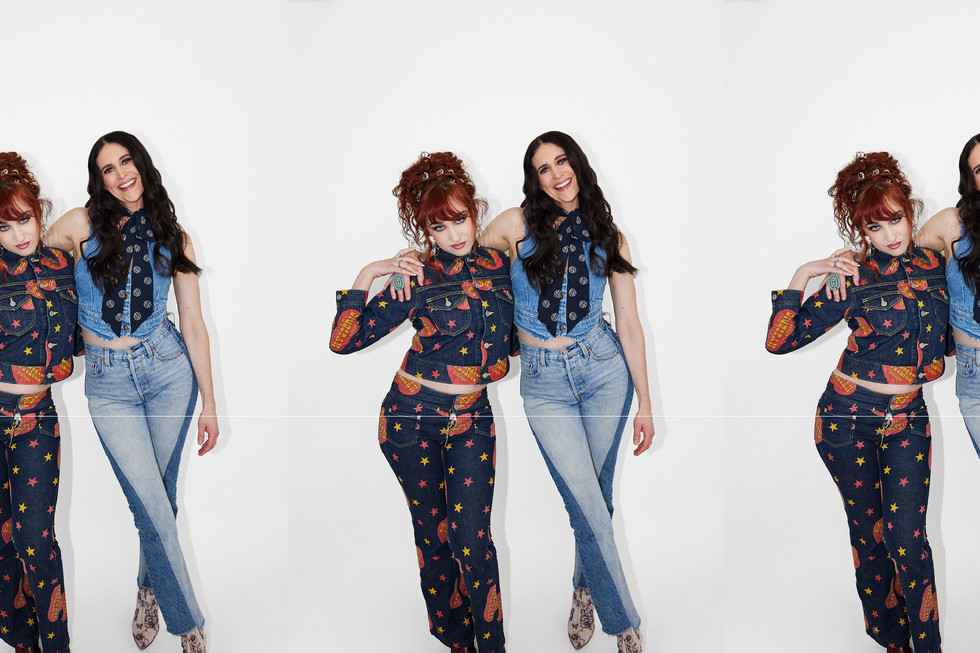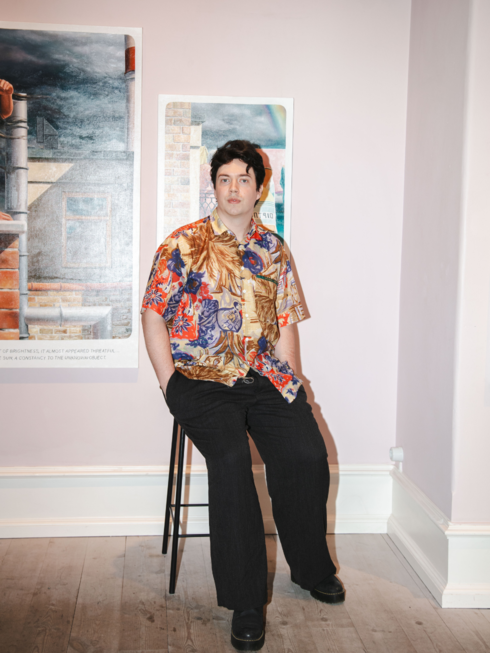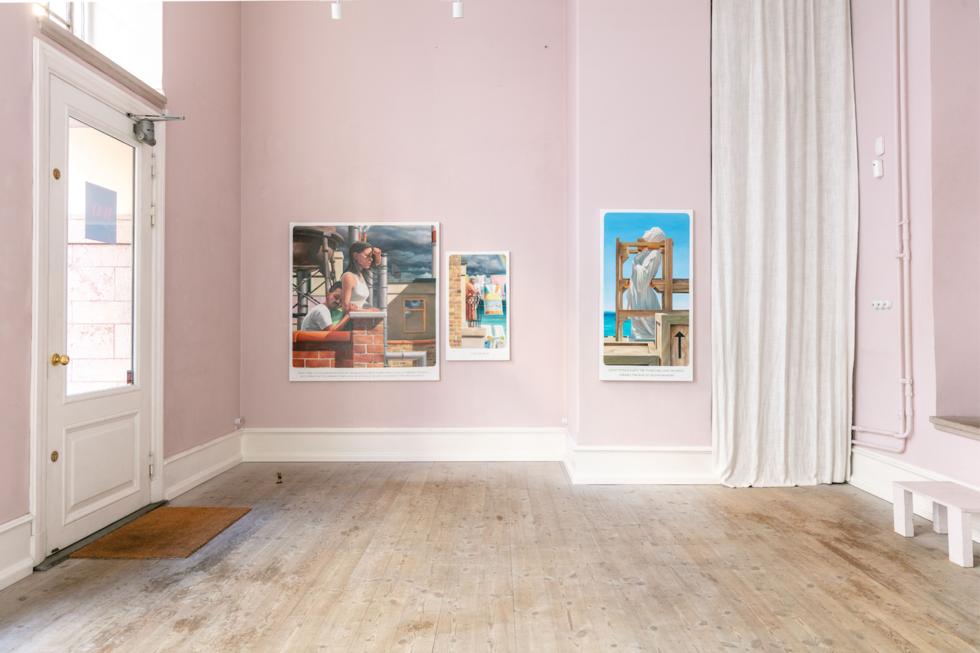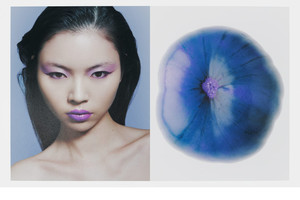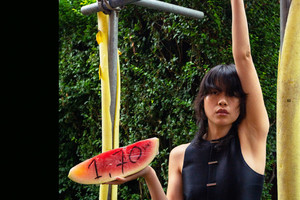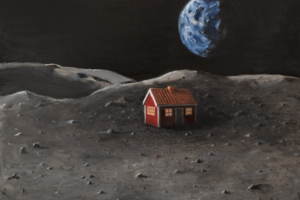Life, Loss, and the Devotional Act of Art-Making with Anton Funck
Written by Natalia Muntean“Whether I made an exhibition about it or not, the loss and grief would still be there. For me, it’s also about showing up as authentic. I don’t want to feel like a stranger to myself. So maybe this is a way of doing that,” says Danish artist Anton Funck. In his latest show, Dear Sun, We Will Meet Again, Funck transforms personal loss into a universal meditation on love, the cyclical nature of life, and the beauty of everyday, mundane moments.
Through his meticulous craft and poetic vision, Funck invites us to expand our horizons and embrace the quiet moments that define us. “Connection is a very important, fundamental feeling,” he says. “I think that’s at the core of me - to feel like I’m connecting with the world in a meaningful way, not just through my art, but in every aspect of life.”
Now on display at Public Service Gallery, his debut solo exhibition in Sweden showcases an extensive series of watercolour paintings on handmade paper, emphasising his contemplative and spiritual approach to the medium, along with his tactile experimentation with materials. Against a backdrop of grief, Funck’s work is abundant in colour, poetry, light, and life.
Natalia Muntean: Can you walk me through your rituals or things that bring you into the zone when you start working?
Anton Funck: It’s really hard because there’s this idea that if you make your hobby your job, you’ll never work a day in your life. But for me, it’s the opposite - you’ll always work. So, it’s important to have some structure. I meditate in the morning, just 10 minutes of focusing on my breath, deep relaxation, and waking up. Then I read a bit, go for a run or a walk, and have some food. If that happens, I feel pretty good for the day. I get to the studio around nine, Monday to Friday, and keep office hours: nine to six. It’s pretty meat and potatoes, but it works. I’m always thinking about art and work, so having a framework helps. It’s a way of knowing when to think about it and when not to. If I’m sitting on the couch or at dinner with friends, I can think about it, but I know it’ll happen in the studio. So, I try to be present in the moment.
NM: What happens if you get to the studio and don’t have any ideas?
AF: There aren’t always ideas. But for me, it comes to life when I’m doing it or trying to do it. Thinking about it is good, but the ideas are more like seeds. Doing the thing changes the idea. Sometimes when I’m stuck, I remind myself to just start, to make something, try a different colour. It can be the simplest thing, like painting with silver for the first time. That creates a seed for more. Doing the thing is what gets me going. If I don’t start, it can really mess up my flow. Overthinking before starting is something I have to avoid.
NM: You let your intuition lead you when you work?
AF: Intuition plays a big role, but it’s not just about technique in the traditional sense. For example, in my current show, the images are floaty and abstract, but at the core, there’s a rigid technique, like colouring with lines instead of just the surface. The lines tie everything together. I find something that works visually, something with tactility and vibration, and I follow that as a framework. With woodcuts, for example, you can only go horizontally, vertically, or diagonally. That strict rule creates freedom. I try to create boundaries that, in the end, give me freedom.
NM: So you have boundaries but push them a bit?
AF: If I compare it to writing it’s like wanting to write about nature, but only having 300 words, or about regret in 100 words, the limitation helps. A big subject, but you can only say so much. That works well for me.
NM: It definitely reduces overthinking and sets you on a specific path. Your background is in music - how did the transition to visual art happen?
AF: Yes, since I was about 11 or 12, my first love was music: guitar, bass, rock, electronic, and film scores. I played in bands and toured Europe and the States. It was formative because it shaped how I would like to be in the world. I thought about music 24/7. That was my thing until I was around 26 or 27. Just before COVID, my band had been on a long tour, and I burned out. I started getting into mindfulness meditation and found myself thinking about sewing and tapestries. It was strange because I never thought of myself that way. I asked my sister to teach me to sew, and the moment I started, I knew I could do it forever. It was peaceful. Then because of COVID, we couldn’t tour, and people started buying my tapestries. My best friend, who's an architect, helped me cultivate a work ethic around it -, we go to work, we do the thing and we try as hard as we can with the art stuff. He really believed in me from the get-go. I owe a lot to him.
NM: It's great that you decided to follow that curiosity.
AF: I was quite greedy about it in the beginning. I was really drawn to it all the time, and it stimulated a part of me that I didn’t even know existed. There was also a reinforcing factor in that I could sell it, and people appreciated it from the very beginning. Having that positive reinforcement mattered a lot. Given my background in music, I also had a foundation for establishing it as a business. So, one thing led to another, and long story short, I began getting exhibitions and all these opportunities, and I just went for it.
NM: You mentioned that starting to play music at a young age and touring helped you understand who you want to be in the world. So, who do you want to be in the world?
AF: Who do I want to be in the world? I don’t know. I’ve been reflecting a lot on the concept of identity over the past few years, especially at this stage of my life where I’m sort of this “artist” making exhibitions, travelling with my art, and talking about it frequently. When I consider this question, I realise that where I want to be in the world is heavily influenced by my own personal desires. I want the freedom to pursue this because I feel extremely privileged to be able to do so. However, it’s also shaped by what needs to happen for me to maintain that freedom. Ultimately, I don’t know exactly who I want to be in the world. There are many hedonistic desires I have, like anyone else, but I find contentment in recognising that who I want to be is closely tied to who I am right now. Being able to engage in my work in a meaningful way, while honoring the privilege it brings, is incredibly fulfilling to me. I have my share of problems and challenges, but at the core of it all, being able to do this creatively is likely who I aspire to be in the world. That said, I often struggle to connect with the world in other ways, which many artists experience, as it can take over everything. I want to be someone who is more connected to the world, but for now, I’m quite content with who I am, as long as I continue to grow in various aspects of my life.
NM: That’s a nice state to be in - having that sense of contentment.
AF: I think it’s about feeling like you’re growing. Often, when I’ve felt down or depressed, or when I see others feeling that way, it’s because they feel stuck, lonely, or like they don’t play a significant role in others’ lives. Connection, in the broad sense, is a very important, fundamental feeling. I think that’s at the core of me - to feel like I’m connecting with the world in a meaningful way, not just through my art, but in every aspect of life.
NM: A good conclusion to come to - that community and relationships are probably at the core of what life is about. Staying on the subject of music, how do you think music influences your practice nowadays if it does?
AF: It’s funny because after I stopped playing music, something shifted. When I was making music, I stopped listening to a lot of it because I was fatiguing my ears with hours of practice. I also lost perspective on how much beautiful, diverse music there is in the world. I had narrowed my scope, thinking music was one thing, but now I see it as this metaphysical condition of everything in the universe. When I stopped creating music, I just enjoyed the gift of sound, and it opened my mind to all sorts of music.
At this stage in my life, I’m extremely curious about music that isn’t overtly autobiographical but still says something about the musician’s life, even if it’s an upbeat jazz track or heavy techno. I’m drawn to that in my art now, where you can be ephemeral in how you express what’s going on in your life. For example, I’ve been listening to Bill Evans’ album You Must Believe in Spring, which is an ode to him losing his brother. Listening to it through that lens, I hear so much more in the moody jazz. It’s opened my mind to different forms of expression. At the same time, I listen to music in a very open way, just enjoying how fun or different it is. But with my art, I’m more narrow-minded. I’m trying to create a specific type of art, and I’m very drawn to that, even if it means I’m not as open to other styles.
NM: If we can talk about your exhibition with Public Service Gallery - who is the sun you will meet again?
AF: I think, in general, throughout the exhibitions I’ve made in the last couple of years, there’s a red thread of something cyclical in all my works. Whether it’s the orb as an object, symmetry, or repetition, there are a lot of cyclical elements. Even before I made art, I’ve always been drawn to philosophical, existential themes - like the tree of life, or different stages of life. I spend a lot of time in my personal life thinking about these stages, reflecting on earlier and later phases. Life feels like a linear human experience but with cyclical themes happening again and again. How you change your perspective on the same things throughout life, that’s something I’m very drawn to.
The title, Dear Sun, We Will Meet Again, speaks to that more openly. I made this exhibition during a period when I lost my brother, so it’s also my little hidden ode, a devotional mention of him. It’s very two-sided in that sense.
Originally, the exhibition was inspired by a lot of reading I’d been doing, particularly by the poet David Whyte. He writes about many themes in life, but one poem, Horizons, really stood out to me. It talks about inner and outer horizons, losing your horizon, and the conflict between inner and outer horizons became the theme. During the creation of this exhibition, my horizon, my scope, and my life narrative changed quite dramatically. There was a sudden obstruction in my life narrative.
Of course, that wasn’t something I set out to make art about, it was just something happening in my life. But I tried to let it fuel the fire of creation. I don’t know how I feel about that yet, but I felt I had the option to do it or not. And it felt more meaningless not to do it. For me, it’s a very public way of trying to understand something. I think that’s a crazy premise of making art, but I’m more drawn to artists who do that, who treat real, dramatic things in their life than those who don’t.
NM: Was it uncomfortable for you to be this public with your pain?
AF: Yes, it’s still uncomfortable. There’s a side of it where I feel very naked. I’m still on edge about whether I’m paying a high price in the future for being so open about grief and loss. But at the same time, I’m very grateful to all the artists and people who’ve shared their experiences while going through them. That’s always helped me a lot during hard times. It’s not so much about helping others or breaking taboos, it’s more about paying respect to those who’ve done it before me. It’s about carrying on that tradition of being open about the hard things in life: grief, sorrow, loss. The people who’ve done that before me have helped me tremendously, and I feel this is a way of passing on that respect.
NM: You said you don’t know if you’ll pay a high price in the future for being so open. What would that price be?
AF: I think, for example, when you make something ephemeral or abstract, like paintings, people often look for a buzzword or a red thread to latch onto. I don’t know if, in the future, people will refer back to this as, “Oh, he made an exhibition about losing someone very close to him.” There are a lot of artists in the past who’ve done the same, and it’s often referred to as a peak moment in their artistic pilgrimage. But for them, it might not be so important anymore. I don’t fear it too much because I feel strong enough to push through it, but I do worry about being involuntarily drawn back to that narrative a lot. That’s the price of doing anything - you don’t get to choose what people attach to it.
NM: Maybe I’m projecting, but I don’t see a way of separating yourself from this loss. It will taint everything you do, your choices, your work. But initially, you wanted to focus on external motifs like nature and celestial bodies. How did losing your brother shift the course of the show?
AF: It was really a two-part thing. Originally, I was looking forward to creating a show about horizons and the natural world. I had just been in a group show called Landscapes, and I was excited to explore how our perspectives on the natural world change. For example, we talk a lot about the climate crisis, and a Danish philosopher, Nikolaj Schultz, talked about how not only is the landscape changing, but our perception of it is changing too. As the world shifts, with war, climate change, and political upheaval, it changes us in drastic ways. It alters how we see our lives, our past, and our role in the natural world. I was curious about this metaphysical idea of how everything is changing our perspective, both personally and collectively. That’s what I was thinking about while making these paintings. It felt energising and interesting, and I loved having conversations about it. It felt nerdy, but in a good way, just the innocent thoughts of an artist who likes to paint landscapes.
Then, shockingly, my brother passed away. For a long time, I didn’t even make the connection. It was just a shocking, tragic thing that happened. It felt out of control, scary, and sad. But when I returned to the studio, I started looking at everything through that lens. In a weird way, it blended with what I had been thinking about before, but in a much more concrete way. It became about how your outer landscape changes, but it also changes you in a dramatic, profound way. Maybe the inner changes are even more drastic than the outer ones. It all fit together in this unexpected way. I’m still trying to make sense of it, but it also clarified my thoughts about the show. It became a very public, real way of expressing that, of having a conversation with the world about it. It was a choice in the end. I’ve always been drawn to artists who talk about what’s going on in the world and inside themselves, like David Bowie, Alvaro Barrington, Louise Bourgeois, or Nick Cave, who’s also talked about grief and loss.
NM: David Whyte’s poem suggests that if you refuse to face your inner horizons, it closes you off from understanding. How did this exhibition help you understand things or face your inner horizons? And do you hope the audience will expand their horizons or face their inner struggles?
AF: That’s a really beautiful question. When I went through this experience of loss and grief, it struck me how common it is. It happens to most people, whether in a shocking, dramatic way or a quieter one. It also stripped away a lot of superficial burdens I had put on myself. One of the themes of the show became love, not just romantic love, but the love of connection, of feeling close to others. It reminded me of the importance of having a north star, a horizon that embraces love as the foundation of a life well-lived. It’s love for others, but also love for the small, mundane things that make you happy every day. It’s about finding beauty in the quiet, non-dramatic moments.
When you do an exhibition, there’s this idea of people clapping, paintings selling, and all the noise of the art world. But in reality, it’s the opposite. We don’t have to do this. We could just sit down together with love and grace and have a simple coming together. That’s what’s beautiful. It’s not about the art industrial complex. I don’t want to impose this on others, but I’ve realised how lucky I am to have people who want to see my work, talk about grief, and experience life together. Even seeing someone frustrated in a supermarket because the line is too long, that’s beautiful because it means they don’t have bigger problems. It’s a reminder of the privilege of being alive and okay, even for a moment. It’s still something I’m processing. I don’t want it to sound like I’ve found salvation, but that’s where I am right now.
I don’t know if you ever fully understand how it changes you, or what losing someone close does to you. I think it shifts over time. I lost people earlier in life, and it does eventually settle. But it hasn’t yet. This time, I’m trying to be more mindful of the different stages. Maybe this is just where I am now, and I know it could easily shift into a more pessimistic place. But I also feel this shield of love, which is healing. It’s making me more open to the people around me and that’s something I don’t think I’ve experienced as much before.
NM: Were you more closed off before?
AF: Yeah, I think it’s second nature for me to be a bit antisocial, internalising a lot but not always expressing it or acting on it. I’m good at talking about things, but maybe not always living them out through action. I think I’m doing more of that now. It doesn’t take a huge effort, just sincerity, honesty and being present.
NM: You’ve described your artistic practice as more than just making images, but a lifestyle. How does that philosophy influence your daily life and your approach to art?
AF: I think in modern society today, we often have this idea that we have a life and then we have a job, and we sort of shape our lives around this job. I can't really speak to whether it's a capitalist idea or something else, but when we think about someone having a job, they have their lives, and they have their job, and they shape their life around their job, or their job around their life, like work-life balance and all these things. For me, of course, there’s a sort of separation to my art practice. There’s an odd industrial complex that reflects the capitalist framework of selling and producing, sort of squaring it all up into something edible that we can put into the world.
But for me, to approach art and be productive within it, while also making progress in my art-making pilgrimage, it’s really important to let your inner life and your art life inform each other. So for me, it’s a devotional practice. It's something I do every day, an integral part of my thoughts and my inner ecosystem. There’s no disconnect between the two; it's almost something that can't be articulated fully. It becomes this devotional practice where what I do in my daily life outside of the studio deeply informs what happens in the studio, and vice versa.
In a very practical sense, it has established a deep friendship with my best friend, where we talk a lot about who I need to seek out to learn how to line wash a canvas? Or where do you source this specific material? It becomes about how to engage with the world and who to seek out and form connections with. In paper making, you look for people who know something about it, and you connect with them in a very profound way. They have one goal, and you have another, but you share a mutual goal. It may seem mundane, but for me, it results in very meaningful encounters with people I wouldn’t have met otherwise.
If you're mindful of it and want to expand your horizons with art-making, it can truly connect you with people you didn’t realise you needed to meet. I think that's a beautiful thing, especially since we're often conditioned to stay in a narrow lane and not explore what lies outside it unless it’s a drastic decision. Things are streamlined and optimised for efficiency, but art-making, filmmaking, music-making, and anything in the arts represent the last frontier where we're compelled to venture into the unknown: absorbing information, seeking help, and forming connections.
So, that’s part of the job, in a way, and I'm extremely grateful for the flexibility that comes with it. I highly encourage other artists to expand their techniques and explore how they can make art, not just for the sake of improving the art itself, but for all the other experiences it offers you. Even if it doesn’t lead anywhere, it allows you to step out of your bubble.
NM: So there’s no separation between Anton the artist and Anton the person?
AF: I think it’s all part of my inner life, for sure. The only time there’s a separation is when I’m involved with the business side of things. If I have a job, it’s the business side of my art: accounting, taxes, pricing, shipping, and meetings with galleries. I like that side, but it’s only 20% of it. The other 80% is art-making, and there’s no separation there. When I’m doing the business side, it’s not all of me, it’s more like the left or right side of my brain at work. But I appreciate and respect that side. It’s not about endorsing the art industrial complex, but I know it’s necessary in order for me to do this sustainably.
NM: Tell me about techniques - I know you used watercolours for this show and also made the paper.
AF: Yes, I made some of the paper, not all of it. Some of it is 300 grams, and some is 600 grams. For me, paper is incredibly versatile and accessible to paint on, just like watercolours. You don’t need a lot of knowledge to appreciate or approach it but you can get a lot out of it without fully understanding it.
When I was making tapestries, I often hit obstacles where I needed to learn about fabric, sewing, techniques, traditions, and history. I loved that, it expanded my horizons, but it was also necessary to avoid messing things up, like making something that would fall apart in six months. With watercolours and paper, it’s liberating. You can just sit down, pick up a colour, and start. But over time, I got curious about making my own paper. You can make high-quality paper quite easily from cotton or mulberry pulp. You blend it with water, the cellulose comes out of the fibres, and then you put it in a sift and let it dry. Once it’s done, you have this rough, rustic piece of paper that can last hundreds of years if treated right.
I started experimenting with that and found it beautiful - the idea that you made the paper yourself. How many people actually make their own canvas? Some do, but many don’t. Recently, I also learned how to make watercolours. It’s very simple, just raw pigments, mixed with honey, and water. That’s how it’s been done for thousands of years.
My partner cultivated this idea of seeking out ancient techniques for making paints, colours, and canvases. Once he opened my mind to it, I got really attracted to it. It adds a nice layer of personality - like, “Oh, you made the watercolour yourself. You mixed that colour.” Oil painters do it too, but I haven’t seen it done much with watercolours. So I thought it was interesting to try. For the show, it was mostly about the watercolours, not the paper. It’s not that hard, but for me, it was eye-opening and inspiring.
NM: I can imagine! You’re basically creating everything from scratch.
AF: Exactly. It feels good to do that. There are so many decisions involved that inform the outcome. It expanded my horizons, and it’s super easy and fun!
NM: Besides making paper and watercolours, you also write.
AF: I do. I wouldn't say I have a writing practice, but I do write. I write a lot of notes, and I do a lot of voice recordings, like memos, and I journal. But when I write, it's more like in preparation for a show, where it becomes more like automatic writing - “What is this show actually about?” I blurt it out, then I condense it and boil it down. I try to make it more clear to myself what it’s actually about. And I’ve found that, in the last two years, to be quite uplifting, because, for me, it was quite hard in the beginning to talk about my art, especially publicly. I knew that it was about something, but I wasn't sure what exactly. Because art-making is a language in itself, and in an ideal world, you wouldn't have to say much, because you already say so much through the works, through the craft, and through the devotional practice of coming to your studio and shaping your whole life around it. I think you say so much through that act. So, I was quite against the idea of talking about art. But I realised I was also just trying to protect myself a little bit. So talking about it, and learning to cultivate a language around it, has been a learning experience. And I’ve used writing as a tool in that if that makes sense.
David Whyte has a very beautiful point about talking about poetry. He says you can't actually talk about poetry; you can only talk about poetry via poetry. Like, you can only explain the poetic with poetry. And I think it’s a little bit the same with art. As soon as you have a language for it, where you're explaining it, it’s not really artistic, it becomes explanatory. But you can explain art through poetry, I think. And that’s where I feel like those two are interlinked. Or music through poetry, you know?
NM: Is there anything you’re looking forward to?
AF: At the moment, I’m looking forward to having a bit more time to create my next show. I have an exhibition in November, and I’m obviously looking forward to that, but I’m also excited about spring coming. In Scandinavia, spring is such an orchestral, dramatic event. I’m looking forward to that little rollercoaster. I’m also looking forward to sleeping more.
NM: What do you hope viewers take from the exhibition?
AF: What do I hope? I hope that, if I can hope for anything, it's that they find a moment of peace where, just for a moment, they take a pause and feel like they take a moment for themselves to take something else in. Whether it’s in my art, visually, or just some thoughts that occur while looking at it, that’s entirely out of my control. But at the very least, I hope it gives some pause in some sort of nourishing way. Solace is the word I’m thinking about.
NM: That’s a beautiful gift to give to people.

